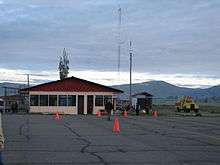Jauja
Jauja (Shawsha Wanka Quechua: Sausa,[2] Shawsha[3] or Shausha,[4] formerly in Spanish Xauxa, with pronunciation of "x" as "sh")[5] is a city and capital of Jauja Province in Peru. It is situated in the fertile Mantaro Valley, 45 kilometres (28 mi) to the northwest of Huancayo (the capital of Junín Region), at an altitude of 3,400 metres (11,200 ft). Its population in 2015 was 15,432 .[6]
Jauja | |
|---|---|
Town and municipality | |
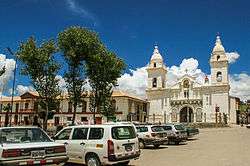 Vista de la esquina del Jr. Grau y Junin hacia la iglesia de la plaza mayor de Jauja | |
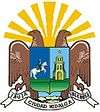 Seal | |
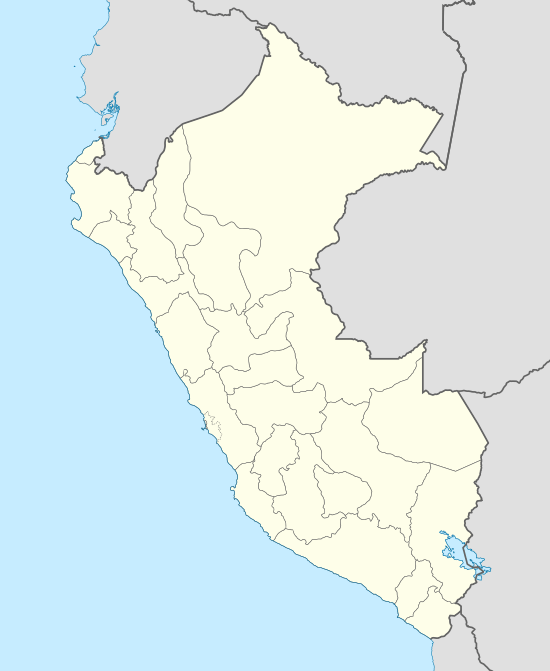 Jauja Location of in Peru | |
| Coordinates: 11°46′30″S 75°30′00″W | |
| Country | |
| Region | Junín |
| Province | Jauja |
| Established | April 25, 1534 |
| Elevation | 3,400 m (11,200 ft) |
| Population | |
| • Estimate (2015)[1] | 15,432 |
| Time zone | UTC-5 (PET) |
| Website | municipality of jauja |
Jauja, which flourished for a short time, was once the capital of Spanish Peru, prior to the founding of Lima as the new capital.[7] Its name is referenced in the popular Spanish expression país de Jauja, which literally means "country of Jauja", but is used figuratively to mean a “never never land" or a "land of milk and honey”. The town, with a laid back ambiance and salubrious climate, has narrow streets with houses painted blue. Laguna de Paca lake is close to the city.[7][8]
History
Previous to Inca era, the area formed part of the Xauxa-Wanka confederation, a town was inhabited by Xauxa people in the vicinity before the Incas. The Xauxas eventually accepted Inca domination, being renowned warriors Xauxa contributed with soldiers to the campaigns of political and military expansion towards Quito.
During the initial expansion of Inca civilization, Incas established the provincial administrative center of "Hatun Xauxa", the head of the province or wanami of Xauxa. The city of Xauxa was interconnected with the rest of the empire by the main section of the Qhapaq Ñam highway, a royal road connecting Cusco to Quito.
After the Inca Emperor Wayna Qhapaq died in Quito, his body paused at Xauxa, en route to Cusco, as means of respect for the city and his inhabitants because they had been some of the most loyal to his cause of pacifying the northern provinces, roughly modern-day Ecuador.
When Inca civil war broke out, Xauxas supported the Waskar-led faction. Xauxa became military headquarters for the southern faction army against Atawallpa,[9] Xauxa provided soldiers, supplies, storage, etc. to a number of Waskar's generals such as Atoc "The Fox", Hango,[10] or Guanca Auqui the son of Wayna Qhapaq and a Xauxa wife.[11]
Eventually, the Waskar's troops lost the city at the hands of the Inca general Challco Chima as Atawallpa's army continued advancing south towards Cusco.
After capturing Cusco, the Atawallpa general Quiz Quiz took Waskar hostage and imprisoned him in a fortress of Xauxa, he would be later drowned in the nearby Andamarca river.[12]
Months after the Battle of Cajamarca, impatient for the Atwallpa's ransom to be fully paid, waiting at Cajamarca, Francisco Pizarro sent his brother Hernando Pizarro to Pachacamac and Cusco in order to the recollect part of the ransom payment. Upon his return to Cajamarca, Hernando meets Challco Chima in the Xauxa Valley, where he was stationed with his army of 35,000, Hernando deceived Challco Chima by telling him Atawallpa himself requested of his immediate presence at Cajamarca, although suspicious of Hernando, Challco Chima accepted the request and left his army in order to travel with Hernando to Cajamarca where he would be taken captive.
Shortly before Hernando Pizarro arrival to Xauxa, the Waskar's supporting inhabitants revolted against occupying Atawallpa's army and Challco Chima responded by beheading the leaders of the revolt and putting their heads on pikes, for their supporters he ordered the mutilation of men's and women's hands and tongues and that this occurred in the Pampa de Maquinwayo, 5 miles (8.0 km) south of present-day Jauja[13] A Cusquenian noble accompanying the Spanish named Antamareca Mayta, a supporter of Waskar's faction on the civil war, fiercely faced Challco Chima, calling him on the assassinations, Challco Chima immediately responded by attacking the noble or "orejon" (name used by the Spaniards to refer Inca nobles because of the ceremonial earplugs they wore) but they were separated.[14]
"Until when, Chalco Chima, your cruelties must end. When will it be the day that you and that fierce beast of your captain Quizquiz have had enough of human blood. Tell me, rabid puma (puma-ranra)"[14]
Later, advancing towards Cuzco, Pizarro's force stopped in Xauxa, where Francisco had Challco Chimac burned alive because of suspicions of secret communications between him and Quiz Quiz, Spanish paranoid increased after the sudden death of Topa Wallpa, who was affiliated to Waskar's Cusco-based faction on the Inca civil war.
"Xauxa was a considerable town...seated in the midst of a verdant valley, fertilized by a thousand little rills, which the thrifty Indian husbandmen drew from the parent river. There were several capacious buildings of rough stone...and a temple of some note."[15]
Today the partial ruins of this settlement can be seen on a hill, approximately 3 kilometers (1.9 mi) southeast of the town.[16]
After the Spanish had sealed the conquest of Peru by taking Cusco in 1533, Spanish conquistador Francisco Pizarro established Xauxa as Peru's first capital in April 1534. It was named "Santa Fe de Hatun Xauxa" in keeping with the Quechua name.[13] In the same year, Pizarro and his men discovered that Xauxa was home to huge accumulations of Inca food, clothing and wealth. The Spaniards recognized that they could live comfortably for months.

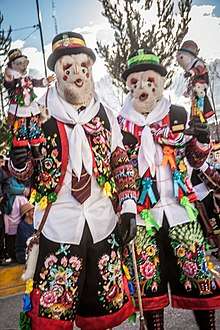
When the decision was made in 1535 to move the capital to Lima to take advantage of proximity to the port (Callao), Lima began to overshadow Jauja's importance. During colonial times, Jauja became dependent upon Tarma. Later Huancayo, increased in importance and surpassed Jauja as a commercial centre. Between 1742 and 1756, Juan Santos Atahuala led an uprising in the mountains of Jauja, one of many revolts that would occur in Peru over the years.[17] The first mayor of Jauja was Don Arias Villalobos.[13]
Jauja's dry climate was recognized, however, as being beneficial for patients with respiratory tract tuberculosis. In this regard, the Jauja hospital cared for many Spaniards. The wealth that they brought to Jauja helped it regain in popularity and strengthened the legend of "the land of Cockaigne". With the establishment of the sanatorium "Domingo Olavegoya" Jauja patients came from many parts of the world, making Jauja a cosmopolitan city. This was described in the novel Páis de Jauja, by Edgardo Rivera Martínez. Tombstones with names from all over the world can be seen in the Jauja cemetery, but after the development of antibiotics, the city began to lose its importance as a health mecca.[13] The small city, however, has retained much of its colonial-era charm. Over the years the people of Jauja have come to refer to their town and region as "el páis de Jauja"; this name was also used in Rivera's book on the area and its culture.
Geography and climate

Jauja lies in the fertile Mantaro Valley at an altitude of 3,352 metres (10,997 ft). It is located along Highway 3S which eventually leads to Lima, 40 kilometres (25 mi) to the northwest of the regional capital of Huancayo. 4 kilometres (2.5 mi) to the north of the town is Laguna de Paca, covering an area of 21.4 square kilometres (8.3 sq mi).[18] To the west of the town, near the village of Chocon, is the Laguna Tragadera. Villages located in close proximity to Jauja include Huerta, Jauja|Huerta, Viscap, Huaripampa, Julcán, Jauja, Ataura, Masma, Mantaro, Huamali, Muquiyauyo, Chocon and San Pedro de Chulan and Yauli, to the east of Laguna de Paca to the north.
The river that originates in the Mantaro River Valley, is called the Mantaro River that flows near the Jauja town into a large alluvial plain. Montaro River valley forms the central highlands of Peru bounded by towering Cordillera ranges which has three tributary valleys known as the Masma, the Paca and the Yanamarca. Formation of this region is attributed to diverse sedimentary, glacial and tectonic activity. The valley formation is dated to the Late Pliocene and early Pleistocene uplift unconformity.[19] Its location is about 8 kilometres (5.0 mi) to the south east of La Oroya town (a smelting centre of mining industry), 60 kilometres (37 mi) to the south of Tarma and 40 kilometres (25 mi) to the north of Huancayo.
The dry climate of the city made Jauja a common place for tuberculosis sufferers to move to since the dry air was good for the kidneys and lungs. Its climate and its relative proximity to the capital of Lima (250 kilometres (160 mi)) made it common for the inhabitants of the city of Lima to travel to this area continually. The weather is divided into three distinct seasons - the rainy season from November to April, winter from May to July and the dry sunny season, with strong winds from August to October.
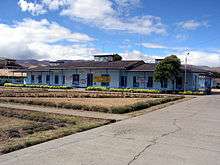
Culture
Today, Jauja is a city whose main activity is in the retail trade of agricultural products produced in the Mantaro Valley. Its streets are narrow and the houses are mainly built in the Republican Andean style from adobe plastered with plaster, with large wooden doors or hallways.

The pristine town is famous for its Wednesday and Sunday markets. Barrio La Libertad is one of the older neighbourhoods and is nestled in the eastern part of the city. Its plaza, also named La Libertad, contains a monument atop of which is a golden eagle.[20] An archaeological museum is located in the town, which has exhibits of the ancient Huari culture. The town also has a fossil museum, a collection by a local man. The hill that forms the backdrop for the town has a fine row of Inca Stores and large number of circular buildings representing the Xauxa culture. Laguna de Paca lake also has number of such stone buildings in ruins.[8][21]
Festivals
The cultural life in the city is vibrant, with many festivals and social and religious events taking place throughout the year. The most popular festival is the Feast of San Sebastian and San Fabian (20 January) when Tunantada is celebrated for one week. Tunantada derives from the Spanish 'Tunantes'. Some believe that the origin of the dance lies at the end of the Viceroyalty of Peru and the dawn of the Republican era of Peru. Through this dance of the festival, the natives imitate the Spanish, commemorating the years that the Spanish and natives existed alongside in Jauja.[22] Locals dress up in the form of satirical wire mesh masks, eyes, whiskers and painted white complexion. Some of the dancers carry a baton and wear their pants to the knee, as if they were pure-blooded Spanish. The music initially starts with violin sounds, and then the sounds of clarinets,andean harps, saxophones, etc.
Other important festivals include Carnival (February and March), the anniversary of the Spanish foundation of the city (April 25), Independence Day (July), Herranza (August), Feast of Mamanchic Rosario, patron saint of Jauja (October), and Adoration of the Child (December).[23]
Churches
The Xauxas were the earliest settlers in this town, before the Inca also made it their home. This historical town is now seen only in ruins, with three notable carved wooden altars seen as a witness, in a modern adobe church built later in the town. Dating from 1564, the Jauja Cathedral (Iglesia Matriz de Jauja) was built in Baroque and Rococo style.[24] Interior highlights include double drop ceiling tiles, finely carved wooden altars,[25] colonial retablos, and the image of Our Lady of the Rosary (patron of Jauja).The church required rebuilding after collapsing in March 1836 when Estanilslao Marquez was the pastor. The systematic reconstruction was initiated in 1914 by parish priest Fr Paul. The façade was completed in 1921 under Father Barrier, a leading architect of religious buildings. Interior renovations began in 1928. The back of the presbytery includes Solomonic additions.[20] The bell tower is modern and contains brass bells that can be heard for miles. In 1906, a chiming clock was incorporated under pastor Dr. Sixto G. Davila.
Built in Gothic style, the Capilla Cristo Pobre church ("Poor Christ Chapel") is one of the most notable architectural examples in Jauja. It is patterned after the, Notre Dame. Via Crucis's paintings, brought from France, are on display at the Capilla de Cristo Pobre. The church is administered by the Daughters of Charity and is part of the San Vicente de Paul High School.


Legend
In Spanish language, Jauja is also the name of the proverbial "Land of Cockaigne" where people can live without having to work. Over time, in folk song and legend, the Valley of Jauja became associated with the Land of Cockaigne. However, it was the riches of the real Jauja at the time of the Spanish conquest that created this myth. The myths sometimes depict Jauja as an island and other times as a city in a mythical land. Along the Texas-Mexico border, La ciudad de Jauja is known as a comic folksong about the legend of Jauja as the "Land of Cockaigne".[5]
The Legend of the Laguna de Paca, by Poet Laureate (of Jauja, and the Mantaro Valley), Dr. Dennis L. Siluk (2011)
In a related vein, Jauja is the setting for an episode of "Prisoners of the Sun", one of the books in the comics series on the Adventures of Tintin by the Belgian artist Hergé.
High schools
- Colegio Estatal Industrial Integrado Juan Maximo Villar de Jauja (Ex 501)
- Colegio Nacional San Jose de Jauja
- Colegio Nuestra Señora del Carmen de Jauja
- Colegio San Vicente de Paul de Jauja
- Colegio Sagrado Corazon de Jesus
- Colegio Enrique F. Gomez Espinoza
- Colegio Juan Pablo II (private)
- Colegio San Agustín
- Colegio particular Jauja
Transport
Jauja is connected by highway to Lima and La Oroya. Jauja is the only city in the center of the country with an airport, Francisco Carle Airport. Jauja airport was officially recognized in 1995 and currently receives daily commercial flights. It is currently served by one airline carrier, LATAM. Most travelers to domestic and international destinations connect in Lima's Jorge Chávez International Airport.
Notable people
References
- Perú: Población estimada al 30 de junio y tasa de crecimiento de las ciudades capitales, por departamento, 2011 y 2015. Perú: Estimaciones y proyecciones de población total por sexo de las principales ciudades, 2012-2015 (Report). Instituto Nacional de Estadística e Informática. March 2012. Retrieved 2015-06-03.
- Smith, Gavin (1989-11-15). Livelihood and Resistance: Peasants and the Politics of Land in Peru. University of California Press. ISBN 9780520912021.
- Rick Floyd (1992), "Una comparación entre el quechua Shawsha y el quechua Wanka." In: Estudios etno-lingüísticos II Archived 2016-03-02 at the Wayback Machine, Stephen G. Parker (ed.), pp. 102-135. Documento de Trabajo 23. Yarinacocha: Ministerio de Educación and Instituto Lingüístico de Verano.
- John R. Wroughton (1996), Gramática y textos del quechua Shausha Huanca Archived 2016-03-03 at the Wayback Machine. Documento de Trabajo 30. Pucallpa: Ministerio de Educación and Instituto Lingüístico de Verano.
- Paredes, Américo (1995). A Texas-Mexican cancionero: folksongs of the lower border. University of Texas Press. p. 6. ISBN 0-292-76558-4.
- "Peru". Citypopulation.de. Retrieved 7 October 2010.
- Barrett, Pam (2002). Peru. Langenscheidt Publishing Group. p. 319. ISBN 981-234-808-5. Retrieved 2010-10-07.
- "Huancayo Information". Peru 4U. Retrieved 2010-10-08.
- Ayala, Felipe Guamán Poma de (August 1978). Letter to a king: a Peruvian chief's account of life under the Incas and under Spanish rule. Dutton. ISBN 9780525144809.
- Betanzos, Juan de (2010-06-28). Narrative of the Incas. University of Texas Press. ISBN 9780292791909.
- D'Altroy, Terence N. (1992-08-17). PROVINCIAL POWER IN INKA EMPI. Smithsonian.
- Vásquez, Aquilino Castro (1992). Hanan Huanca: historia de Huanca Alta y de los pueblos del valle del Mantaro : desde sus orígenes hasta la república (in Spanish). A. Castro Vásquez.
- "Historia de Jauja". achperu.com (in Spanish). Retrieved 8 October 2010.
- Perú, +Historia del. "Calcuchimac". Historia del Perú (in Spanish). Retrieved 2018-12-22.
- Prescott, William Hickling (1904). History of the conquest of Peru.
- Rachowiecki, Rob, Beech, Charlotte (2004). Peru (5 ed.). Lonely Planet. p. 232. ISBN 1740592093.CS1 maint: uses authors parameter (link)
- Chaliand, Gérard; Berrett, A. M. Mirrors of a disaster: the Spanish military conquest of America. p. 123.
- "La Laguna de Paca". Absolut Peru. Retrieved 7 October 2010.
- Altroy, Terence N.; Christine Ann Hastorf (2001). Empire and domestic economy. Springer. p. 56. ISBN 0-306-46408-X. Retrieved 2010-10-07.
- "Iglesia Matriz Santa Fe de Jauja". jaujamiperu.com. Archived from the original on 7 April 2010. Retrieved 8 October 2010.
- Murphy, Alan; Ben Box (2003). Peru handbook. Footprint Travel Guides. p. 484. ISBN 1-903471-51-6. Retrieved 2010-10-07.
- "Origen de la Tunantada". Jaujinos.com. Archived from the original on 13 July 2011. Retrieved 7 October 2010.
- "Jauja". aventura4000.org (in Spanish). Retrieved 8 October 2010.
- Rivera Martínez, Edgardo (1993). Páis de Jauja [Country of Jauja] (in Spanish). Lima: La Voz Ediciones. p. 86.
La iglesia matriz fue construida como la primera catedral de los españoles en America del Sur." Translation: "The main church was built as the first cathedral of the Spanish in South America.
- Rachowiecki, Rob; Beech, Charlotte (2004). Peru. Lonely Planet. p. 232.
External links
- Locally made Website Jaujamiperu
- Another site with pictures and information
- La tierra de Jauja, a 1547 sketch (paso) by the Spanish playwright Lope de Rueda in which two thieves steal from a simpleton, distracting him with tales of the marvels of the land of Jauja.
- Jauja Ciudad Hidalga y Valerosa. In Spanish.
| Wikimedia Commons has media related to Jauja. |
